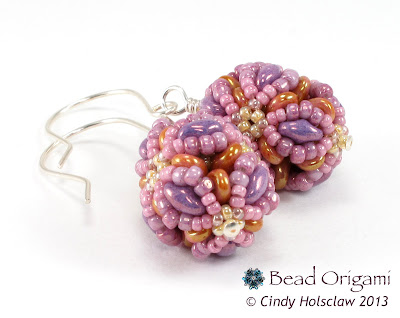Tropical Dahlia (left) and Rivoli Kaleidoscope (right) Pendants
Center Rivoli vs Outer Rivolis
A big visual difference between the two designs is the focus between the center and outer rivolis. The Rivoli Kaleidoscope has three different kinds of rivolis, and shows off more of the outer rivoli pendants at the expense of the center rivoli. The Tropical Dahlia, on the other hand, leaves much more room to show off the center rivoli. I like that I was able to accomplish this in a rivoli design, as it's often difficult to bezel a rivoli with beadwork without covering most of it up.
Tropical Dahlia Pendant
Symmetry Difference
Another difference between the two designs is the symmetry difference; the Tropical Dahlia Pendant has 10-fold symmetry, while the Rivoli Kaleidoscope has 8-fold symmetry. This difference not only gives the Tropical Dahlia more detail, but it's also reflective of the symmetries that you're more likely to see in a flower vs. a kaleidoscope.
Tropical Dahlia (left) and Rivoli Kaleidoscope (right) Pendants
Of course, as I mentioned earlier this week, the Tropical Dahlia Pendant can be woven in 12-fold symmetry for a larger variation. A larger variation of the Rivoli Kaleidoscope can be created too, and both patterns describe the changes necessary to create these larger variations.
Size Matters?
Finally, the Rivoli Kaleidoscope is ever so slightly larger than the original Tropical Dahlia, but it's also slightly smaller than the larger Tropical Dahlia variation.
Tropical Dahlia (left and right) and Rivoli Kaleidoscope (center) Pendants
They range from 27 to 32 mm in diameter.
The patterns for the Rivoli Kaleidoscope Pendant and Tropical Dahlia Set are available exclusively at beadorigami.com if you'd like to make your own!
Which design is your favorite? Drop me a line in the comments section below!





















































